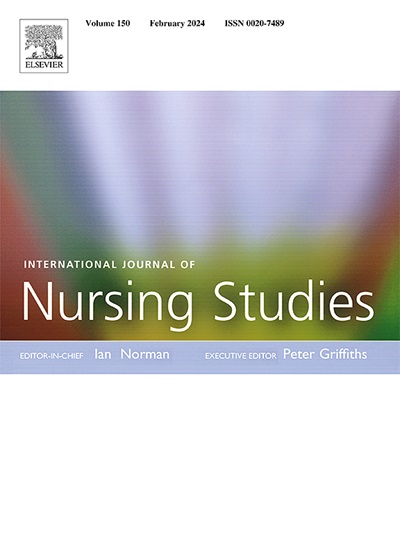在重症监护室使用护理数据进行基于机器学习的预测建模:范围综述
IF 7.1
1区 医学
Q1 NURSING
引用次数: 0
摘要
护理数据可以帮助早期发现患者病情恶化并预测患者预后。此外,机器学习的快速发展突出了对重症监护病房患者临床预后预测模型的需求。虽然纳入危重病人护理过程中产生的护理数据的预测模型正在增加,但尚未全面了解所使用的特定类型的护理数据和这些模型来预测健康结果。目的:本综述旨在确定基于机器学习的模型的研究现状,这些模型利用护理数据来预测重症监护病房患者的健康结果,重点关注这些模型中的护理数据类型。方法本综述通过系统文献检索进行,截止到2023年12月,涉及7个数据库。纳入了利用机器学习和护理数据来预测重症监护病房成年患者预后的文献。数据被组织成研究、模型相关和护理数据特征。结果共纳入151项研究,发表于2004年至2023年之间,自2018年以来呈上升趋势。超过一半的研究使用开放获取数据开发预测模型,其中重症监护数据的医疗信息集市是最常用的。大多数研究采用监督学习,其次是深度学习和神经网络,而其他方法很少使用。在监督学习技术中,回归是最常用的,其次是增强和随机森林。在预测模型中,护理敏感结局(13.0%)的选择频率低于临床结局(87.0%)。在本综述中,护理资料分为护理量表(n = 150)、护理评估记录(n = 83)、护理活动记录(n = 13)和护理笔记(n = 23),其中以护理量表最为常见。近年来,护理量表和护理笔记呈上升趋势。结论:本综述确定了模型中护理数据的各种应用,以预测危重病人的预后。总体而言,护理量表,客观地显示患者特定健康状况的结构化数据,被使用得最多。由于其他类型的护理数据也具有预测患者临床预后的潜力,因此未来的研究应探索结合各种护理数据的预测模型的开发。这些发现可能有助于深入了解护理数据的使用,并有助于医疗保健提供者和研究人员开发与重症监护病房临床预后相关的预测模型。摘要:本综述确定了模型中护理数据的各种应用,以预测危重患者的预后。本文章由计算机程序翻译,如有差异,请以英文原文为准。
Using nursing data for machine learning-based prediction modeling in intensive care units: A scoping review
Background
Nursing data can help detect patient deterioration early and predict patient outcomes. Moreover, rapid advancements in machine learning have highlighted the need for clinical prognosis prediction models for intensive care unit patients. Although prediction models that incorporate nursing data generated during the care of critically ill patients are increasing, a comprehensive understanding of the specific types of nursing data utilized and these models to predict health outcomes has not yet been achieved.
Objective
This scoping review aimed to identify the current state of research on machine learning-based models that utilize nursing data to predict health outcomes of intensive care unit patients, focusing on the types of nursing data in these models.
Methods
This scoping review was conducted with a systematic literature search until December 2023 across seven databases. Literature that utilized machine learning using nursing data to predict the prognosis of adult patients hospitalized in the intensive care unit was included. Data were organized into the study, model-related, and nursing data characteristics.
Results
A total of 151 studies were included, which were published between 2004 and 2023, with an upward trend since 2018. More than half of the studies developed prediction models using open access data, with Medical Information Mart for Intensive Care data being the most frequently used. Most studies employed supervised learning, followed by deep learning and neural networks, while other methods were rarely used. Among supervised learning techniques, regression was the most commonly used, followed by boosting and random forests. Nursing-sensitive outcomes (13.0 %) were chosen less frequently than clinical ones (87.0 %) in prediction models. In this review, nursing data were classified into nursing scales (n = 150), nursing assessment records (n = 83), nursing activity records (n = 13), and nursing notes (n = 23), with nursing scales being the most frequent. Nursing scales and notes exhibited an increasing trend recently.
Conclusions
This scoping review identified the various utilization of nursing data in models to predict the prognoses of critically ill patients. Overall, nursing scales, structured data that objectively show specific health conditions of patients, were the most utilized. As other types of nursing data also have the potential to predict patients' clinical prognoses, future research should explore the development of prediction models incorporating various nursing data. These findings may contribute to providing insights into the use of nursing data and could aid healthcare providers and researchers aiming to develop prediction models related to clinical prognoses in the intensive care unit setting.
Social media abstract: This scoping review identified the various utilization of nursing data in models to predict the prognoses of critically ill patients.
求助全文
通过发布文献求助,成功后即可免费获取论文全文。
去求助
来源期刊
CiteScore
15.00
自引率
2.50%
发文量
181
审稿时长
21 days
期刊介绍:
The International Journal of Nursing Studies (IJNS) is a highly respected journal that has been publishing original peer-reviewed articles since 1963. It provides a forum for original research and scholarship about health care delivery, organisation, management, workforce, policy, and research methods relevant to nursing, midwifery, and other health related professions. The journal aims to support evidence informed policy and practice by publishing research, systematic and other scholarly reviews, critical discussion, and commentary of the highest standard. The IJNS is indexed in major databases including PubMed, Medline, Thomson Reuters - Science Citation Index, Scopus, Thomson Reuters - Social Science Citation Index, CINAHL, and the BNI (British Nursing Index).

 求助内容:
求助内容: 应助结果提醒方式:
应助结果提醒方式:


